
Quentin Matsys (1466–1530) was a Flemish painter in the Early Netherlandish tradition. He was born in Leuven. There is a tradition alleging that he was trained as an ironsmith before becoming a painter. Matsys was active in Antwerp for over 20 years, creating numerous works with religious roots and satirical tendencies. He is regarded as the founder of the Antwerp school of painting, which became the leading school of painting in Flanders in the 16th century. He introduced new techniques and motifs as well as moralising subjects without completely breaking with tradition.
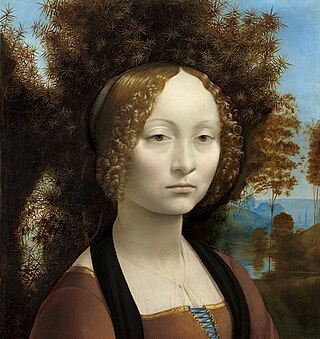
Ginevra de' Benci is a portrait painting by Leonardo da Vinci of the 15th-century Florentine aristocrat Ginevra de' Benci. It was acquired by the National Gallery of Art in Washington, D.C. US from Franz Joseph II, Prince of Liechtenstein in February 1967 for a record price for a painting of between $5 and $6 million. It is the only painting by Leonardo on public view in the Americas.

Margaret, nicknamed Maultasch, was the last Countess of Tyrol from the House of Gorizia (Meinhardiner), and an unsuccessful claimant to the Duchy of Carinthia. Upon her death, Tyrol became united with the Austrian hereditary lands of the Habsburg dynasty.

La Belle Ferronnière is a portrait of a lady, usually attributed to Leonardo da Vinci, in the Louvre. It is also known as Portrait of an Unknown Woman. The painting's title, applied as early as the seventeenth century, identifying the sitter as the wife or daughter of an ironmonger, was said to be discreetly alluding to a reputed mistress of Francis I of France, married to a certain Le Ferron. Later she was tentatively identified as Lucretia Crivelli, a married lady-in-waiting to Duchess Beatrice of Milan, who became another of the Duke's mistresses.

The Lady with an Ermine is a portrait painting widely attributed to the Italian Renaissance artist Leonardo da Vinci. Dated to c. 1489–1491, the work is painted in oils on a panel of walnut wood. Its subject is Cecilia Gallerani, a mistress of Ludovico Sforza, Duke of Milan; Leonardo was painter to the Sforza court in Milan at the time of its execution. It is the second of only four surviving portraits of women painted by Leonardo, the others being Ginevra de' Benci, La Belle Ferronnière and the Mona Lisa.
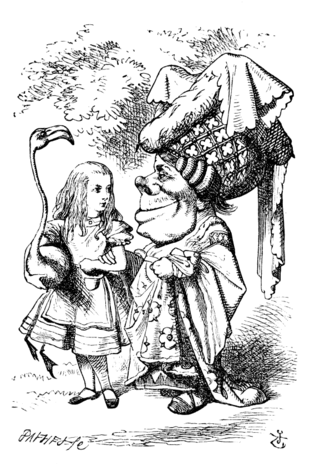
The Duchess is a character in Lewis Carroll's Alice's Adventures in Wonderland, published in 1865. Carroll does not describe her physically in much detail, although as stated in Chapter 9, "Alice did not much like keeping so close to her: first, because the Duchess was very ugly; and secondly, because she was exactly the right height to rest her chin upon Alice’s shoulder, and it was an uncomfortably sharp chin." Her hideous appearance and short stature is strongly established in the popular imagination thanks to John Tenniel's illustrations and from context it is clear that Alice finds her quite unattractive.

The Royal Museum of Fine Arts Antwerp is a museum in Antwerp, Belgium, founded in 1810, that houses a collection of paintings, sculptures and drawings from the fourteenth to the twentieth centuries. This collection is representative of the artistic production and the taste of art enthusiasts in Antwerp, Belgium and the Northern and Southern Netherlands since the 15th century.

Jan Massijs or Jan Matsys was a Flemish Renaissance painter known for his history paintings, genre scenes and landscapes. He also gained a reputation as a painter of the female nude, which he painted with a sensuality reminiscent of the school of Fontainebleau.

Quentin Metsys the Younger was a Flemish Renaissance painter, one of several of his countrymen active as artists of the Tudor court in the reign of Elizabeth I of England. He was the son of Flemish painter Jan Massys, Matsys, or Metsys and the grandson and namesake of Quentin Massys or Metsys.
Events from the year 1513 in art.

The Ill-Matched Marriage is an oil painting by a follower of the early Netherlandish master Quentin Matsys, usually dated between 1525 and 1530. The panel, probably inspired by an original lost drawing of Leonardo da Vinci, illustrates a marriage for economic reasons between persons of different ages. The painting is in the São Paulo Museum of Art. It was donated to the museum in 1965 by the Baron Hans Heinrich Thyssen-Bornemisza.
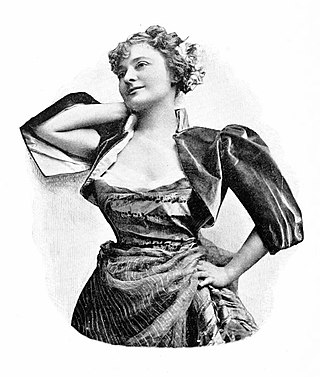
Amalia Küssner Coudert was an American artist from Terre Haute, Indiana, who is best known for her portrait miniatures of prominent American and European figures of the late 19th and early 20th century. Subjects for her paintings include actresses Lillian Russell and Marie Tempest; wealthy socialites Caroline Schermerhorn Astor, Emily Havemeyer ; members of Britain's royal family and London society such as King Edward VII, Alice Keppel, and Consuelo Vanderbilt, the Duchess of Marlborough; as well as members of the Russian royal family, including Czar Nicholas II and his wife, Czarina Alexandra Feodorovna; and wealthy industrialists such as Cecil Rhodes.

The Portrait of Isabella of Portugal is an oil-on-canvas portrait of Isabella of Portugal, Holy Roman Empress by Titian dating to 1548. It was part of the Spanish royal collection and is now in the Museo del Prado in Madrid.

Cornelis van der Geest was a spice merchant from Antwerp, who used his wealth to support the Antwerp artists and to establish his art collection. He was also the dean of the haberdashers guild.
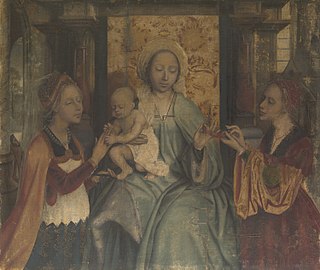
Glue-size is a painting technique in which pigment is bound (sized) to cloth with hide glue, and typically the unvarnished cloth was then fixed to the frame using the same glue. Glue-size is also known as distemper, though the term "distemper" is applied variously to different techniques. Glue-size was used because hide glue was a popular binding medium in the 15th century, particularly among artists of the Early Netherlandish period, who used it as an inexpensive alternative to oil. Although a large number of works using this medium were produced, few survive today, mainly because of the high perishability of linen cloth and the solubility of hide glue. Well-known and relatively well-preserved – though substantially damaged – the most notable examples include Quentin Matsys' Virgin and Child with Saints Barbara and Catherine and Dirk Bouts' Entombment. In German the technique is known as Tüchleinfarben, meaning "small cloth colours", or Tüchlein, derived from the German word for “handkerchief”.

Virgin and Child with Saints Barbara and Catherine is a glue-size on linen painting by Flemish artist Quentin Matsys, probably painted c. 1515–1525. The Virgin Mary is shown on a throne, holding the Infant Jesus, between Barbara and Catherine of Alexandria, two saints popular in the early 16th century and considered the most important of the venerated Fourteen Holy Helpers. Jesus leans forward to place a ring on Catherine's finger, a reference to her vision in which she was to given Jesus by Mary in mystical marriage. Other indicators of the saints identities include the broken wheel - which refers to the torture of Catherine- and the tower, an allusion to Barbara's imprisonment and eventual beheading at the hands of her father.

The Leonardeschi were the large group of artists who worked in the studio of, or under the influence of, Leonardo da Vinci. They were artists of Italian Renaissance painting, although his influence extended to many countries within Europe.

Omnibus Life in London is an 1859 oil-on-canvas painting by British artist William Maw Egley. The work depicts the interior of a packed omnibus carriage. It is held by the Tate Gallery, in London.

Hans Holbein the Younger painted the Portrait of Erasmus of Rotterdam several times, and his paintings were much copied, at the time and later. It is difficult to disentangle Holbein's original work from that of his workshop and other copyists. Possibly five largely original versions survive, as well as a number of drawings made as studies.
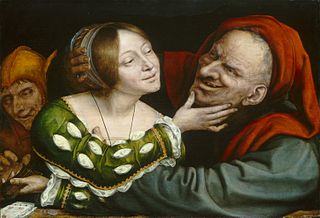
The Ill-Matched Lovers is an oil painting by the early Netherlandish master Quentin Matsys, usually dated between 1520 and 1525. In the collection of the National Gallery of Art in Washington since 1971, the painting depicts the trope that old age can make one foolish. Matsys depicts this theme by showing an older man besotted by a younger, beautiful woman. He gazes at her adoringly, not noticing that with the aid of an accomplice, she is stealing his purse. The face of the old man was influenced by a drawing done by Leonardo da Vinci, demonstrating Matsys’ skill in combining Northern European themes with Italian elements.


























